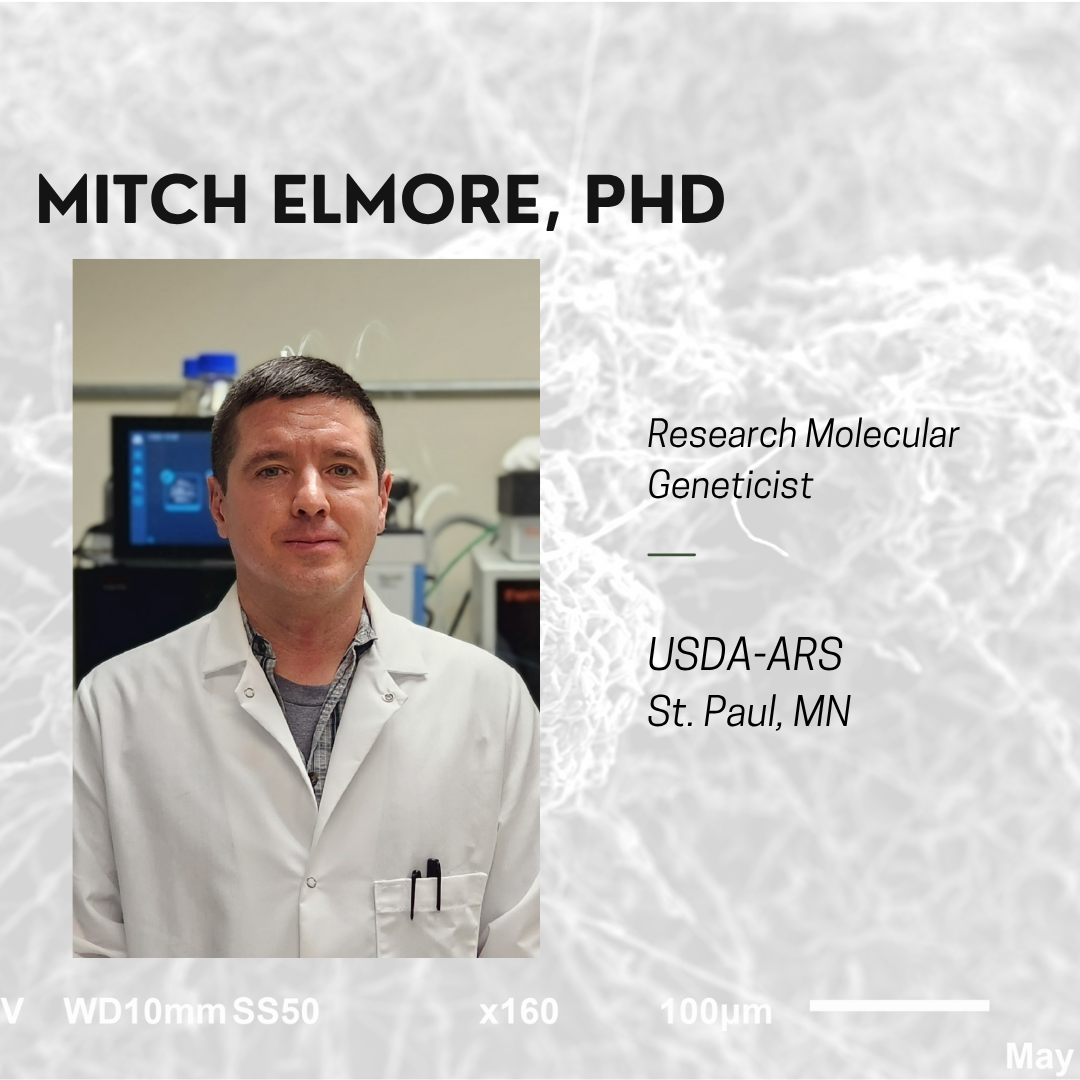Featured Researcher Bio - Mitch Elmore 2025

Meet Mitch Elmore, a research molecular geneticist at the USDA-ARS Cereal Disease Lab in St. Paul, Minnesota. Elmore is currently the chair of the Barley Coordinated Project committee. His research focuses on characterizing host targets of Fusarium effector proteins and reconstructing signaling networks that operate in the host and the pathogen during infection.
Captivated by Plant Microbe Interactions
Elmore grew up in a small town outside central Illinois about an hour east of St. Louis on a farm surrounded by corn, soybeans, and winter wheat fields. Although his parents didn’t farm for a living, the property was always full of animals and plants. He attended St. Louis University for his B.S. degree in biological sciences. While all his classmates were on the pre-medical track, Elmore was more interested in the natural world and thus his first science related job was working part-time in a reptile ecology lab. Toward the end of his degree, he obtained a position at the Danforth Plant Science Center working in a molecular nematology lab studying plant resistance to cyst and root knot nematodes. In addition, he worked on soybean interactions with nitrogen-fixing bacteria. This experience allowed Elmore to hone his skills in molecular biology, creating gene expression constructs, and optimizing hairy root transformation. Since then, he has been fascinated with studying plant-microbe interactions. After graduation, he worked for a couple years in the same lab as a technician, before attending graduate school at the University of California at Davis, where he studied the activation of plant disease resistance in Arabidopsis and the function of pathogen effectors in virulence of Pseudomonas syringae. After graduate school, he was a post-doctoral researcher at USDA-ARS/Iowa State University studying the effectors of barley powdery mildew.
While at the Danforth Center, Elmore had the opportunity to attend a lecture by Norman Borlaug. One thing that really stood out to him was that rice, unlike most cultivated cereals, is immune to rust diseases. Borlaug emphasized to the attendees that understanding the genetic and molecular basis for simple observations could have profound impacts on agriculture and improve the lives of millions of people worldwide. This inspired Elmore to contribute to finding solutions for crop diseases.
Rooted in a Community Based Approach to Solving FHB
In 2021, Elmore started his position at the USDA-ARS and his involvement with the USWBSI began. Because FHB isn’t a disease that can be mitigated in a single way, or “solved” by a single group, he appreciates how the USWBSI reflects this with its very collaborative community. “The USWBSI has been instrumental in generating and applying knowledge to develop many tactics used to reduce FHB and mycotoxins in grains,” said Elmore. Even though FHB is still a major problem in the U.S., he shared that farmers and processors now have more tools at their disposal because of the work of the Initiative.
Since Elmore’s position is rooted in FHB, it’s hard for him to pick just one project as a favorite. However, one project his lab is working on is looking at identifying host proteins that target Fusarium effectors. Elmore is hopeful that by applying this approach to better understand how the fungus infects cereals, they can identify “weak points” which can then be used as gene targets in breeding to reduce wheat and barley susceptibility. Another project is looking at protein-protein interactions to learn how biosynthetic enzymes are assembled in Fusarium and how they work to produce deoxynivalenol with the goal of finding new ways to interfere with mycotoxin production. Finally, the lab is using machine learning to reconstruct host and pathogen signaling networks from gene and protein expression data. These models are then analyzed to predict the most influential genes driving disease outcomes. Thus far, Elmore and his lab have identified some gene candidates of interest and are working towards validation.
Encouraged to Expand Scientific and Non-Scientific Networks
Elmore urges graduate students and post-docs to never lose their curiosity and understand that “failure” is all a part of the research process. More often than not, things in research don’t work out the way they were anticipated, he shared, but if the design of your experiments is solid, you can learn something every time. He also noted that it’s important to remember you can never have too many controls and the best projects are cross-disciplinary.
“Learn as much as you can from others and keep expanding your scientific and collaborative network,” said Elmore. But also, make sure to have a good non-scientific support network which includes hobbies, friends, family, and pets.
For more information about Dr. Mitch Elmore's research, visit his USDA-ARS profile.
To learn more about others in the FHB community, check out all the previous USWBSI Featured Researchers/Advocates.
